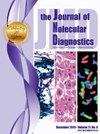利用优化的光学基因组图谱破译多发性骨髓瘤的基因组复杂性
IF 3.4
3区 医学
Q1 PATHOLOGY
引用次数: 0
摘要
常规诊断中多发性骨髓瘤的基因组评估包括分离表达CD138的浆细胞,通常随后进行荧光原位杂交分析。然而,细胞分选通常产生有限数量的细胞,限制了可以使用的探针数量,并将分析限制在最小预后分类所需的少数标记物上。光学基因组图谱是一种高分辨率技术,能够识别整个基因组的结构变异和拷贝数变异;然而,目前它需要100万个细胞。为了克服这一限制,在这项工作中实施了一种创新策略,该策略基于混合来自同一患者的cd138阳性和cd138阴性组分,优化可用的cd138阳性细胞用于全基因组分析。首先,稀释实验表明,50%的cd138阳性混合物足以实现克隆结构和拷贝数变异的完全检测,同时建立了24%拷贝数变异的检测阈值。使用该优化方案,分析了13例患者的13个额外样本。光学基因组图谱与荧光原位杂交对克隆异常的一致性达到93%(13/15),并揭示了荧光原位杂交未检测到的22个额外的基因组变异。该策略将多个分析合并到一个测试中,最小化材料要求,并解决关键预后和越来越多的异常描述,为多发性骨髓瘤患者提供精细分层。本文章由计算机程序翻译,如有差异,请以英文原文为准。

Deciphering Genomic Complexity of Multiple Myeloma Using Optimized Optical Genome Mapping
The genomic evaluation of multiple myeloma in routine diagnostics involves isolating plasma cells expressing CD138, usually followed by fluorescence in situ hybridization analyses. However, cell sorting often yields a limited number of cells, restricting the number of probes that can be used and limiting the analysis to a few markers required for minimal prognostic classification. Optical genome mapping is a high-resolution technology capable of identifying structural variants and copy number variations across the entire genome; however, it currently requires 1 million cells. To overcome this constraint, an innovative strategy was implemented in this work based on mixing CD138-positive and CD138-negative fractions from the same patient, optimizing the use of available CD138-positive cells for genome-wide analysis. First, dilution experiments demonstrated that a 50% CD138-positive mix was sufficient to achieve complete detection of clonal structural and copy number variants, while establishing a detection threshold of 24% for copy number variants. Using this optimized protocol, 13 additional samples from 13 patients were analyzed. Optical genome mapping achieved 93% (13/15) concordance with fluorescence in situ hybridization for clonal anomalies and revealed >22 additional genomic variations not detected by fluorescence in situ hybridization. This strategy consolidated multiple analyses into a single test, minimized material requirements, and addressed critical prognostic and increasingly described anomalies, providing refined stratification for patients with multiple myeloma.
求助全文
通过发布文献求助,成功后即可免费获取论文全文。
去求助
来源期刊
CiteScore
8.10
自引率
2.40%
发文量
143
审稿时长
43 days
期刊介绍:
The Journal of Molecular Diagnostics, the official publication of the Association for Molecular Pathology (AMP), co-owned by the American Society for Investigative Pathology (ASIP), seeks to publish high quality original papers on scientific advances in the translation and validation of molecular discoveries in medicine into the clinical diagnostic setting, and the description and application of technological advances in the field of molecular diagnostic medicine. The editors welcome for review articles that contain: novel discoveries or clinicopathologic correlations including studies in oncology, infectious diseases, inherited diseases, predisposition to disease, clinical informatics, or the description of polymorphisms linked to disease states or normal variations; the application of diagnostic methodologies in clinical trials; or the development of new or improved molecular methods which may be applied to diagnosis or monitoring of disease or disease predisposition.

 求助内容:
求助内容: 应助结果提醒方式:
应助结果提醒方式:


